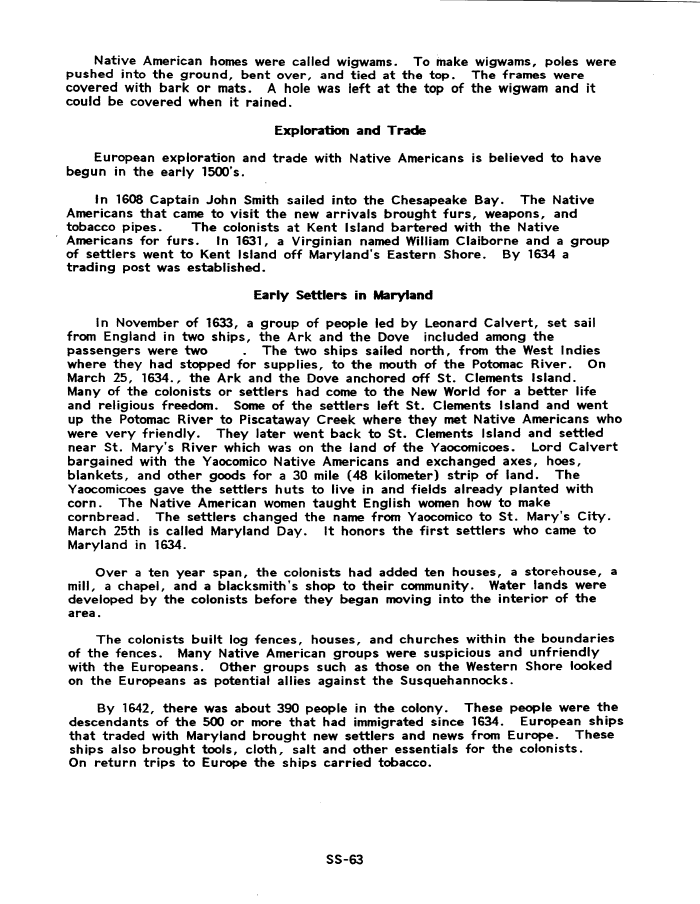 |
||||
|
TASK FORCE TO STUDY THE HISTORY AND LEGACY OF SLAVERY IN MARYLAND (Final Report) 1999/12/31 MdHR 991422 MdHR 991422, Image No: 213 Print image (78K) |
 |
||||
|
TASK FORCE TO STUDY THE HISTORY AND LEGACY OF SLAVERY IN MARYLAND (Final Report) 1999/12/31 MdHR 991422 MdHR 991422, Image No: 213 Print image (78K) |
| Native American homes were called wigwams. To make wigwams, poles were pushed into the ground, bent over, and tied at the top. The frames were covered with bark or mats. A hole was left at the top of the wigwam and it could be covered when it rained. Exploration and Trade European exploration and trade with Native Americans is believed to have begun in the early 1500's. In 1608 Captain John Smith sailed into the Chesapeake Bay. The Native Americans that came to visit the new arrivals brought furs, weapons, and tobacco pipes. The colonists at Kent Island bartered with the Native Americans for furs. In 1631, a Virginian named William Claiborne and a group of settlers went to Kent Island off Maryland's Eastern Shore. By 1634 a trading post was established. Early Settlers in Maryland In November of 1633, a group of people led by Leonard Calvert, set sail from England in two ships, the Ark and the Dove included among the passengers were two . The two ships sailed north, from the West Indies where they had stopped for supplies, to the mouth of the Potomac River. On March 25, 1634., the Ark and the Dove anchored off St. Clements Island. Many of the colonists or settlers had come to the New World for a better life and religious freedom. Some of the settlers left St. Clements Island and went up the Potomac River to Piscataway Creek where they met Native Americans who were very friendly. They later went back to St. Clements Island and settled near St. Mary's River which was on the land of the Yaocomicoes. Lord Calvert bargained with the Yaocomico Native Americans and exchanged axes, hoes, blankets, and other goods for a 30 mile (48 kilometer) strip of land. The Yaocomicoes gave the settlers huts to live in and fields already planted with corn. The Native American women taught English women how to make cornbread. The settlers changed the name from Yaocomico to St. Mary's City. March 25th is called Maryland Day. It honors the first settlers who came to Maryland in 1634. Over a ten year span, the colonists had added ten houses, a storehouse, a mill, a chapel, and a blacksmith's shop to their community. Water lands were developed by the colonists before they began moving into the interior of the area. The colonists built log fences, houses, and churches within the boundaries of the fences. Many Native American groups were suspicious and unfriendly with the Europeans. Other groups such as those on the Western Shore looked on the Europeans as potential allies against the Susqueh an nocks. By 1642, there was about 390 people in the colony. These people were the descendants of the 500 or more that had immigrated since 1634. European ships that traded with Maryland brought new settlers and news from Europe. These ships also brought tools, cloth, salt and other essentials for the colonists. On return trips to Europe the ships carried tobacco. SS-63 |